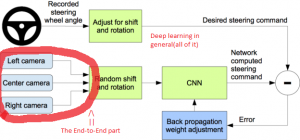End-to-end learning: Difference between revisions
No edit summary |
No edit summary |
||
| Line 1: | Line 1: | ||
<center> | <center> | ||
<blockquote style="padding: 5px; background-color: #FFF8DC; border: solid thin gray;"> | <blockquote style="padding: 5px; background-color: #FFF8DC; border: solid thin gray;"> | ||
[[File:Exclamation.png]] This is student work which has not yet been approved as correct by the instructor | [[File:Exclamation.png]] This is student work which has not yet been approved as correct by the instructor '''WIP''' | ||
</blockquote> | </blockquote> | ||
</center> | </center> | ||
| Line 19: | Line 19: | ||
== Examples == | == Examples == | ||
End-to-end learning is | End-to-end learning is specyfcly prevelant in the auntonomous cars industry(our 2018's case study), as this proces's benefites fitt perfectly with the car's [[Convolutional neural networks (CNNs)]]. As the autonomous car recives multyple paramiters through [[Convolutional neural networks (CNNs)]] at the same time, it is benefitial to use end-to-end learning which is able to | ||
Please include some example of how your concept is actually used. Your example must include WHERE it is used, and WHAT IS BENEFIT of it being used. | Please include some example of how your concept is actually used. Your example must include WHERE it is used, and WHAT IS BENEFIT of it being used. | ||
Revision as of 03:20, 13 July 2017
This is student work which has not yet been approved as correct by the instructor WIP

Introduction[edit]
End-to-end learning is a type of Deep_learning process in which all of the parameters are trained jointly, rather than step by step. [2] Furthermore, just like in the case of Deep_learning, in end-to-end learning machine uses previously gained human input, in order to execute its task accordingly.[3] This proces is specyfcly prevelant in the auntonomous cars industry(our 2018's case study), as this proces's benefites fitt perfectly with the car's Convolutional neural networks (CNNs).
How does it work or a deeper look[edit]
End-to-end learning can be separated into two major parts(symilarly to Deep_learning). Training[4] is the first phase, in which the machine records all of the all of the paramiters human operator uses in what sort of situations(essesed by Convolutional neural networks (CNNs)).[5] Inference[6] then is possyble, with the mashine acting upon previously gained experiance from the traning phase of the End-to-end learning.
The only difference between end-to-end learining and Deep_learning processes is that the end-to-end learning must colect the paramiters jointly(at the same time), while Deep_learning can colect the paramiters jointly or step by step. Therefore, every end-to-end learning is Deep_learning proccess , but not every Deep_learning proccess is step by step learning.
Examples[edit]
End-to-end learning is specyfcly prevelant in the auntonomous cars industry(our 2018's case study), as this proces's benefites fitt perfectly with the car's Convolutional neural networks (CNNs). As the autonomous car recives multyple paramiters through Convolutional neural networks (CNNs) at the same time, it is benefitial to use end-to-end learning which is able to
Please include some example of how your concept is actually used. Your example must include WHERE it is used, and WHAT IS BENEFIT of it being used.
Autonomous Cars WIP
Pictures, diagrams[edit]
As one can see the masterfully edyted picture in paint by the true paint protogy on the right. The cyrcled parameters are assesed jointly(at the same time), while the entire thing still remains to be Deep_learning.
External links[edit]
- It would be helpful
- to include many links
- to other internet resources
- to help fellow students
- Please make sure the content is good
- and don't link to a google search results, please
References[edit]
- ↑ http://www.flaticon.com/
- ↑ https://stats.stackexchange.com/questions/224118/what-does-end-to-end-mean-in-deep-learning-methods
- ↑ https://computersciencewiki.org/images/a/ab/2018_case_study.pdf
- ↑ https://developer.nvidia.com/deep-learning
- ↑ https://computersciencewiki.org/images/a/ab/2018_case_study.pdf
- ↑ https://developer.nvidia.com/deep-learning
